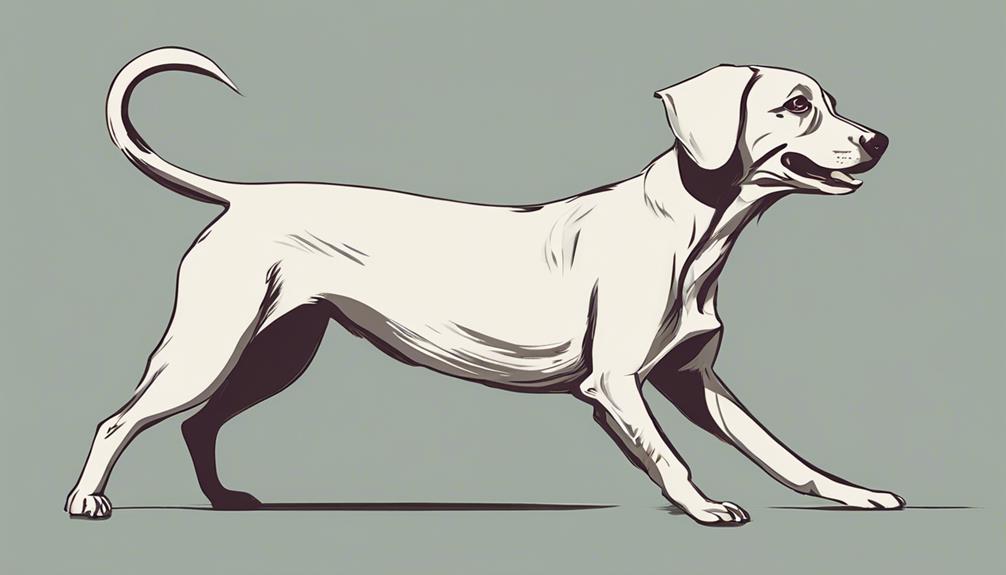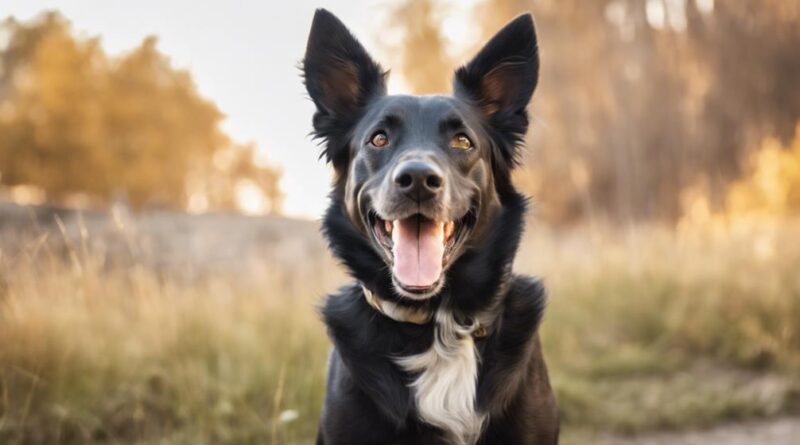Interpreting Your Dog's Happy Signals: A Guide
Have you ever noticed that your dog's tail wagging can actually convey different emotions depending on its speed and position? Understanding these subtle cues can deepen your bond with your furry companion.
But did you know that tail wagging is just one of the many ways dogs express happiness? Exploring these signals can provide valuable insights into your dog's world and strengthen your relationship.
So, what other joyful cues might your canine friend be using to communicate with you?
Tail Wagging
Understanding your dog's tail wagging can provide valuable insights into their emotional state. Tail language is a crucial form of communication for dogs, allowing them to express a range of emotions. The speed at which your dog wags its tail can give you clues about how they're feeling. For example, a fast wagging speed often indicates excitement or happiness. On the other hand, a slow wagging speed might suggest that your dog is feeling unsure or cautious.
When your dog wags its tail in a wide arc, it typically means they're feeling friendly and approachable. In contrast, a small arc or a stiffly wagging tail could signal tension or potential aggression. Paying attention to the way your dog wags their tail in different situations can help you better understand their emotional state and respond accordingly. Remember, tail wagging is just one piece of the puzzle when it comes to interpreting your dog's feelings, but it's a valuable one.
Playful Body Language
Playful body language in dogs often includes bouncy movements, relaxed posture, and a wagging tail. When your dog engages in energetic play, you'll notice a combination of signals that convey their excitement. They may exhibit a playful stance with their front legs lowered, hind end raised, and a wagging tail held high.
During joyful interactions, dogs often initiate play by play-bowing, where they lower their front legs and keep their hindquarters up, signaling readiness for fun. You may observe quick, darting movements, spinning in circles, or even playful nips as they interact. Additionally, dogs might emit playful barks or growls that are typically higher-pitched and softer than those used in aggressive situations.
Pay attention to their body language and vocalizations as your furry friend expresses their delight through these playful behaviors. Enjoy these moments of shared joy and connection as you engage in playful activities with your dog.
Relaxed Posture
When your dog is feeling at ease, their body will exhibit a relaxed posture that signals comfort and contentment. A relaxed posture is a key indicator that your furry friend is in a calm demeanor and experiencing a content expression.
You may notice your dog lying down with their legs slightly splayed out, their belly exposed, and their tail wagging gently. This position shows that they feel safe and trust their surroundings. Additionally, their facial muscles may appear relaxed, with their mouth slightly open and their ears in a natural position. Your dog's breathing will likely be steady and even, further demonstrating their relaxation.
Observing these signs of a relaxed posture can help you understand when your dog is feeling happy and at peace. It's essential to respect and appreciate these moments of tranquility your dog shares with you.
Bright Eyes
Bright eyes are a clear indicator of your dog's excitement and joy. When your furry friend greets you with bright, shining eyes, it signifies their eager engagement and contented expression. In moments of excited anticipation, your dog's eyes may widen, showing their joyful anticipation of playtime or a walk. As you approach, ready to shower them with attention, their eyes may sparkle with happiness, reflecting the joy they feel in your presence.
Pay attention to the way your dog looks at you during joyful greetings; their eyes can convey a wealth of emotions without uttering a single sound. Whether it's the way they gaze at you with adoration or the sparkle that lights up their eyes when they see their favorite toy, your dog's bright eyes speak volumes about their happiness.
Happy Vocalizations
With tails wagging and mouths forming cheerful sounds, your dog's happy vocalizations express their pure joy and excitement. When your dog is feeling happy, their bark frequency tends to increase, becoming more rapid and enthusiastic. The pitch of their barks may also be higher, conveying their positive emotions.
Additionally, you may notice your furry friend whining in a playful manner, which is another sign of their happiness. This whining is often accompanied by panting behaviors, where they may stick out their tongue and appear relaxed.
Understanding your dog's happy vocalizations is essential in deciphering their emotions and strengthening your bond. By paying attention to the frequency, pitch, whining, and panting behaviors, you can better interpret your dog's joyful moments.
Next time you hear those cheerful sounds coming from your canine companion, take a moment to appreciate their happiness and join in on the joyful interaction.
Friendly Approach
To ensure a positive interaction with your happy dog, approach them in a friendly manner that conveys warmth and openness. When you approach your dog in a friendly way, you set the tone for a pleasant interaction and strengthen your bond with your furry companion.
Here are some tips to guide your approach training with positive reinforcement:
- Use a calm voice: Speak to your dog in a soothing tone to help them feel relaxed and at ease.
- Avoid sudden movements: Make slow and gentle movements to avoid startling your dog.
- Offer treats: Use treats as a form of positive reinforcement to encourage your dog's friendly behavior.
- Kneel down: Lowering yourself to your dog's level can make you less intimidating and more approachable.
- Give space: Allow your dog to approach you on their terms, respecting their boundaries.
Play Bows

When observing your dog's behavior, pay attention to their playful gestures such as the playful bows they use to communicate joy and excitement. Play bows are a common form of body language that dogs use to signal their playful intentions. This communication signal involves your dog lowering their front legs while keeping their hind end in the air, often accompanied by a wagging tail and a happy expression. By performing a play bow, your dog is inviting you or other dogs to engage in a friendly and playful interaction. It's their way of saying, 'Let's have fun together!'
Understanding this signal can help you reciprocate appropriately, fostering a positive and enjoyable experience for your furry friend. When your dog play bows, consider reciprocating with your own playful body language to encourage the interaction. This can include mirroring their movements, engaging in light-hearted play, and creating a joyful atmosphere. By recognizing and responding to your dog's play bows, you strengthen your bond and create moments of shared happiness.
Relaxed Mouth
A relaxed mouth on your dog often indicates contentment and ease, reflecting their emotional state through subtle body language cues. When your furry friend displays a relaxed mouth, you can interpret it as a sign of their happiness and comfort in the moment.
Here are some key points to help you understand your dog's relaxed mouth:
- Contented Canines: Dogs with a relaxed mouth are typically content and at ease with their surroundings.
- Joyful Expressions: A relaxed mouth is often accompanied by other joyful expressions like wagging tails and bright eyes.
- Trust and Relaxation: Your dog's relaxed mouth signifies that they feel safe and trust their environment.
- Positive Interaction: During playtime or interactions with you, a relaxed mouth shows that your dog is enjoying the moment.
- Emotional Well-being: A relaxed mouth is a clear indicator of your dog's emotional well-being and overall happiness.
Frequently Asked Questions
What Are Some Common Signs That My Dog Is Feeling Anxious or Stressed?
If your dog is feeling anxious or stressed, it may show signs like excessive panting, pacing, trembling, or hiding. Understanding anxiety is crucial for recognizing distress signals early.
Pay attention to behaviors like whining, yawning, or avoiding eye contact. These signs can indicate your pup isn't feeling their best.
How Can I Differentiate Between My Dog's Happy Signals and Signs of Aggression?
To differentiate between your dog's happy signals and signs of aggression, pay attention to their body language. Recognizing fear signals like ears pinned back or a tense body can indicate aggression.
On the other hand, understanding play behavior, such as a relaxed body posture, wagging tail, and play bows, suggest happiness. Be observant of subtle cues and context to accurately interpret your dog's emotions.
Can a Dog's Tail Wagging Indicate Other Emotions Besides Happiness?
When your dog's tail is wagging, it can show more than just happiness. Tail language is a key way dogs communicate their emotions. Different emotional tail movements can indicate various feelings, not just joy.
Understanding these cues can help you interpret your dog's state of mind accurately. Additionally, pay attention to stress signals beyond just tail wagging to get a fuller picture of how your furry friend is feeling.
Are There Any Body Language Cues That My Dog May Use to Communicate Discomfort or Fear?
When your dog is stressed or uncomfortable, they might display certain body language cues. Recognizing stress in dogs involves paying attention to signs like lip licking, yawning, or avoiding eye contact.
Understanding discomfort can also be indicated by a tense body posture, ears pinned back, or tail tucked between the legs. By being observant of these signals, you can better respond to your dog's needs and provide a sense of safety and security.
What Should I Do if My Dog Is Displaying Mixed Signals or Conflicting Body Language Cues?
If your dog is displaying mixed signals or conflicting body language cues, handling confusion is key. Pay attention to your dog's overall behavior and try to identify the root cause of the conflicting signals.
Stay calm and observe carefully to understand what may be causing the confusion. By resolving contradictions and maintaining a patient and understanding attitude, you can help your dog feel more at ease and communicate more clearly.
Conclusion
So next time you're spending time with your furry friend, keep an eye out for these happy signals. By understanding your dog's body language and vocalizations, you can strengthen your bond and ensure they're feeling happy and content.
Remember, a wagging tail, bright eyes, and playful behavior are all signs that your dog is in a good mood and enjoying their time with you. Keep up the good work and keep those tails wagging!
